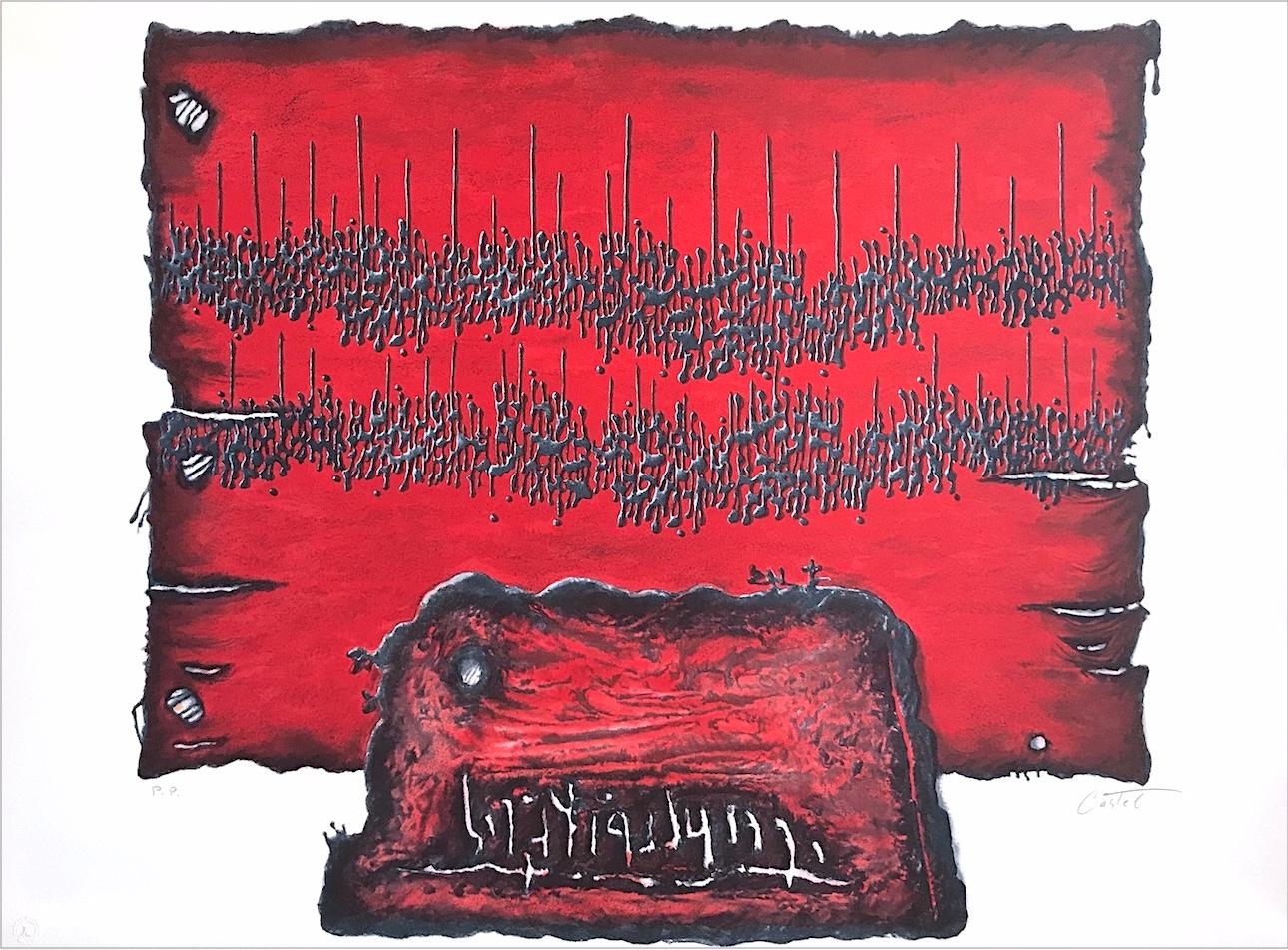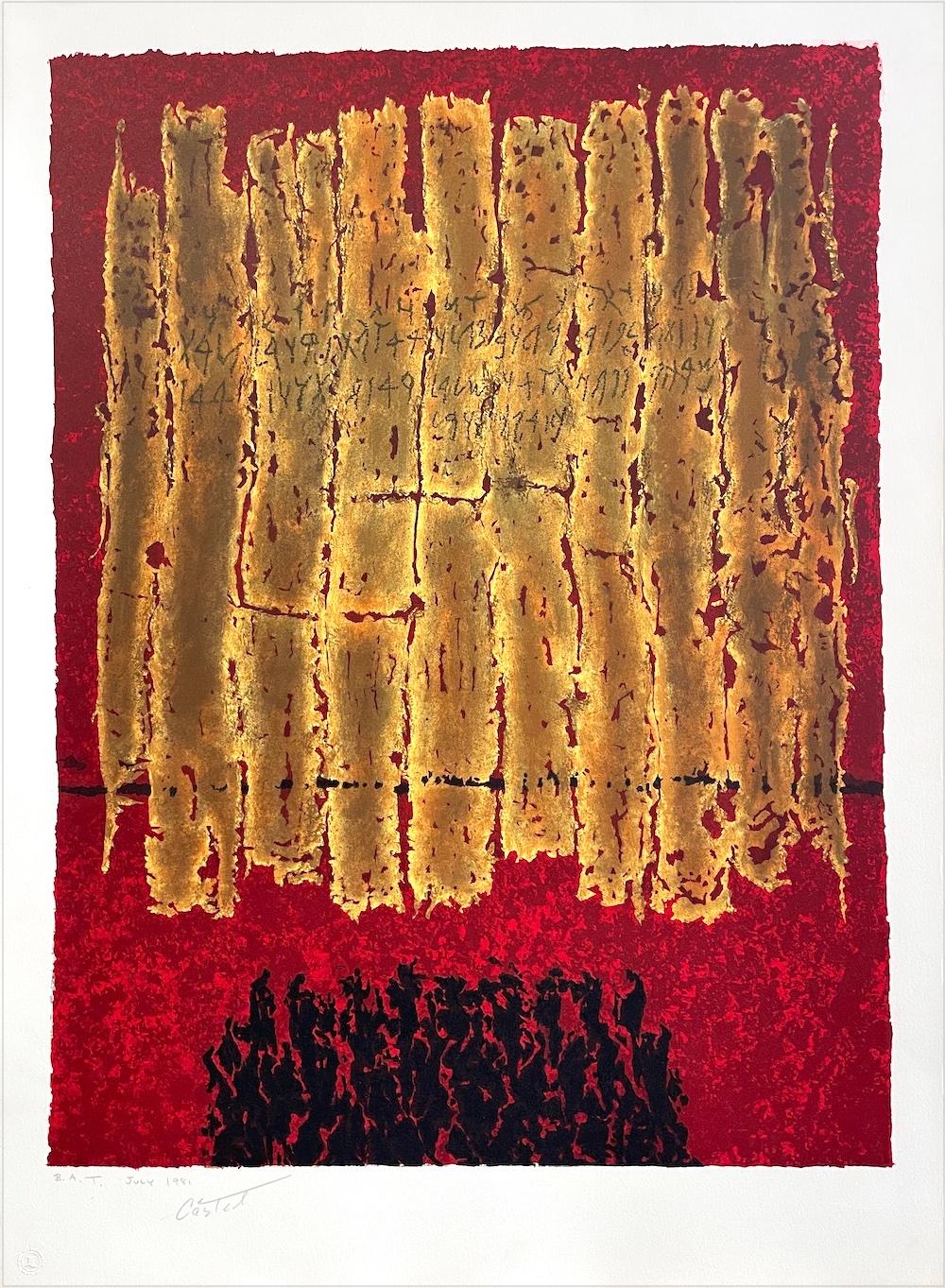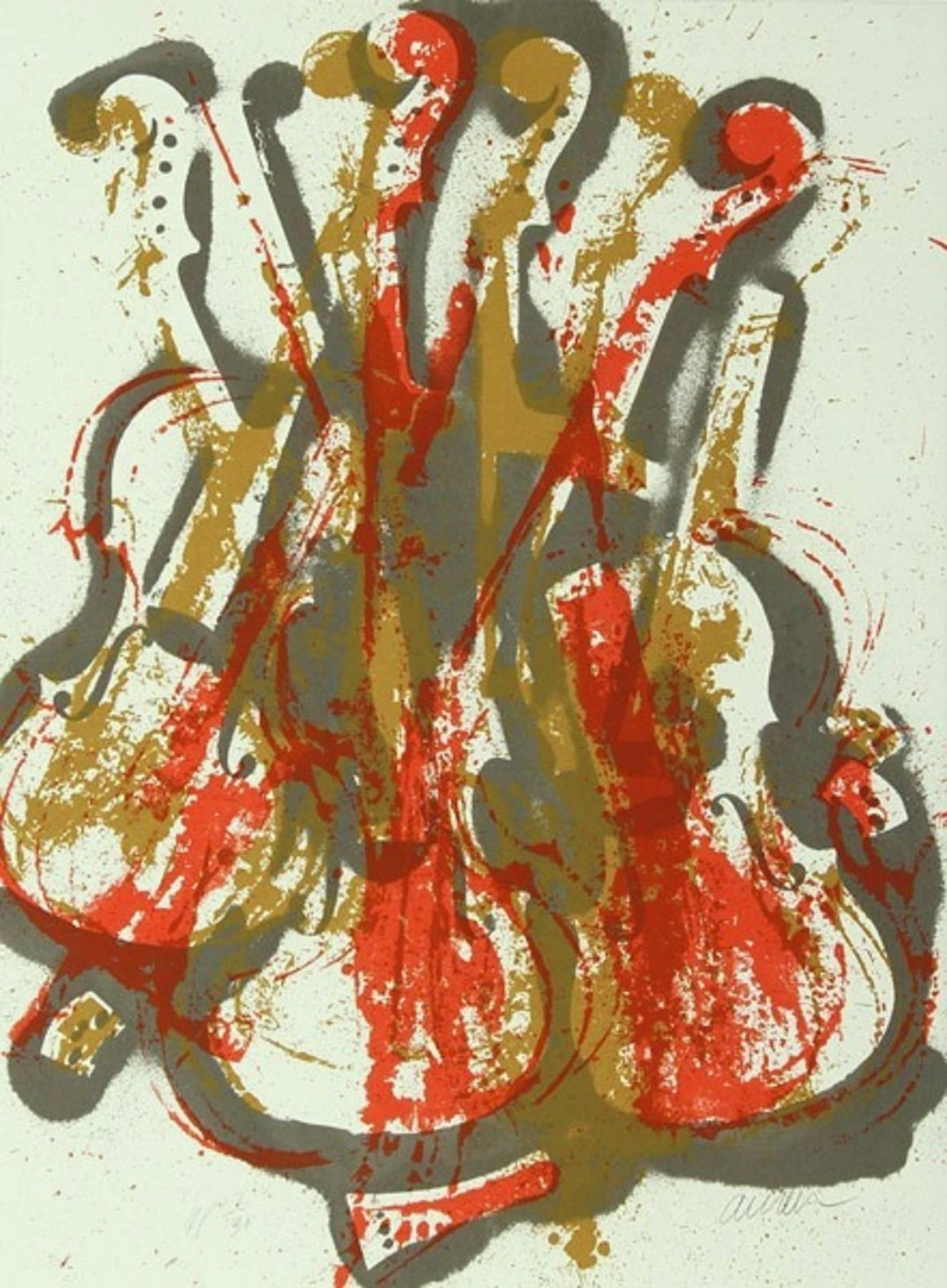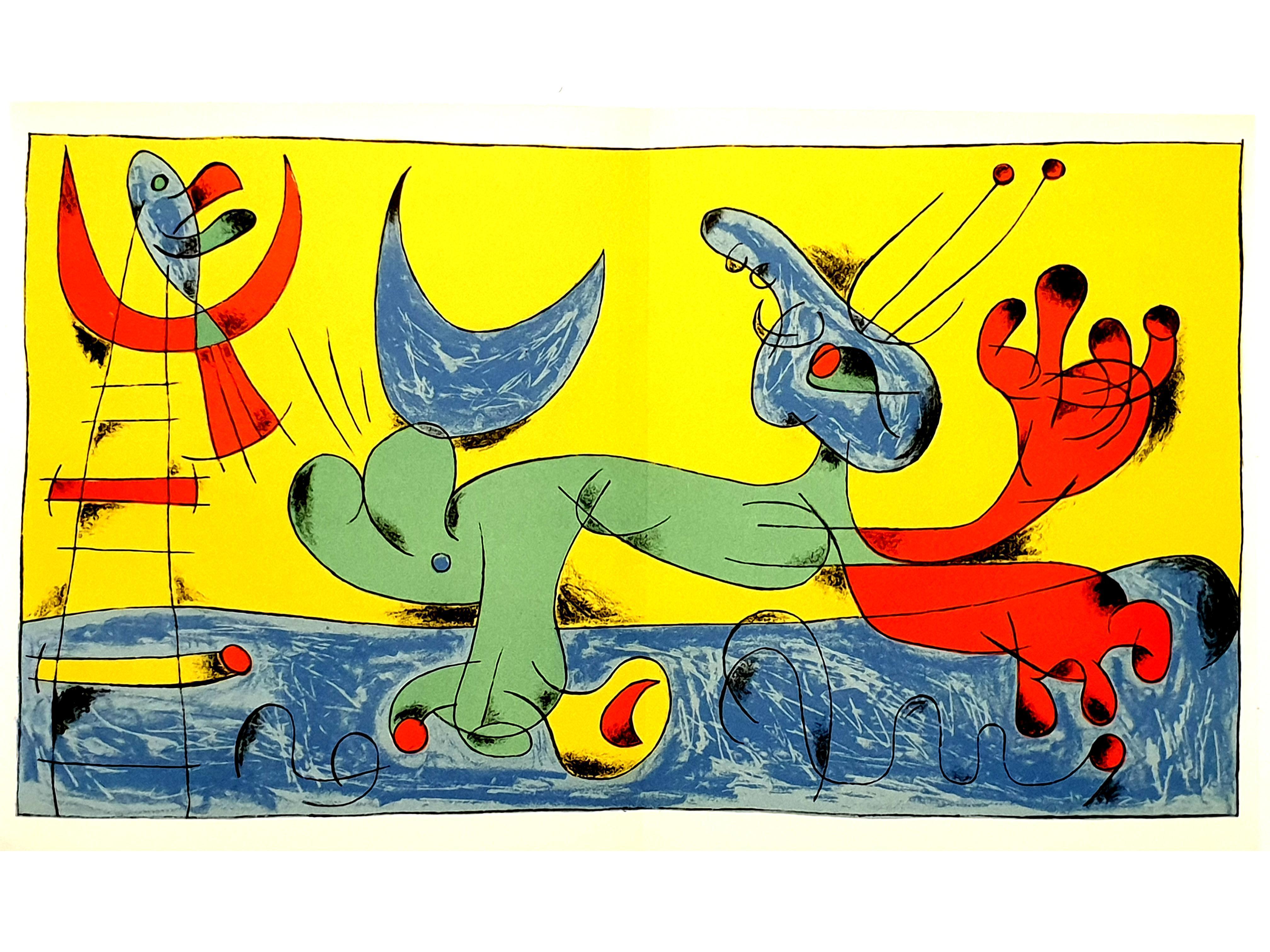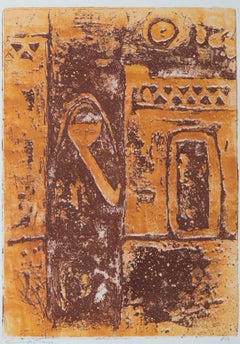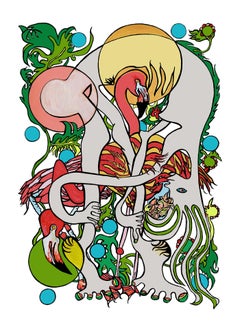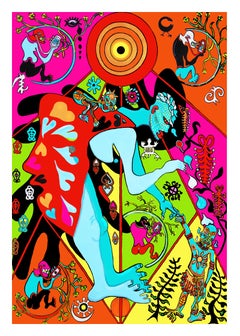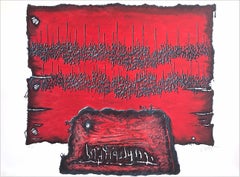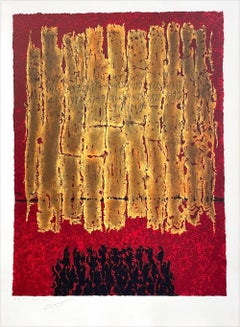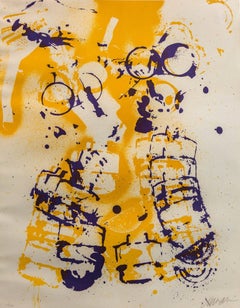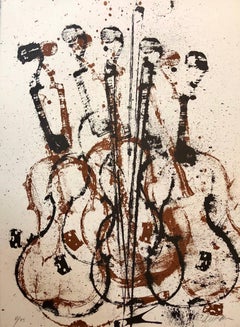Items Similar to "Crescent" (FRAMED) Abstract Lithograph 10" x 12" in (1967) by Zaccaria Zeini
Want more images or videos?
Request additional images or videos from the seller
1 of 9
Zaccaria Zeini"Crescent" (FRAMED) Abstract Lithograph 10" x 12" in (1967) by Zaccaria Zeini1967
1967
About the Item
"Crescent" (FRAMED) Abstract Lithograph 10" x 12" in (1967) by Zaccaria Zeini
Medium: lithograph
Signed and dated
Zaccaria El Zeini (1932 - 1993) was raised in the popular district of Sayyida Zienab in Old Cairo and graduated from the Faculty of Fine Arts in the city’s capital, where his graduation project revolved around the birth of the female saint, the namesake of the area where he was born. He was a postwar Modernist who received his formal training in painting in Venice, graduating from the Academy of Pravana, and it was in Italy that he gained his fascination with Greco-Roman architecture, which would develop into a preferred subject in his painting. He later became a professor at his alma mater, the Faculty of Fine Arts, and ended his career as head of its painting department. El Zeini’s oeuvre spans predominantly expressionist and abstract-figurative painting styles, with a strong proclivity towards using different personal symbols in his work and throughout several periods. These symbols connote each of the three wives he had during his life, and he cryptically places these symbols as markers throughout his paintings, whether discreetly or overtly. His formative upbringing in the Sayyida Zeinab district remained one of the most significant influences on his trajectory as an artist, having been exposed to since birth the popular celebrations and festivities surrounding the birth of the granddaughter of the Prophet Muhammed.
The first period was predicated on the quintessentially Egyptian practices and folk rituals and rites of ‘el moulid’ and ‘el zar.’ His work has always been distinguished for portraying the human figure (face and torso) enclosed in a geometric shape of either a square or a rectangle, often in a prominent contrasting color like green or red against backgrounds in predominantly neutral and earthy textured tones. Despite this rigid, enclosed portrayal, the viewer still feels the sympathy that the painter emotes toward these human beings living or oftentimes trapped, in this constrained and confined space in the reductionist form of a house, door, or window. El Zeini used this form of representation as a commentary on the impacts of societal constraints, norms, prejudices, and discrimination. It was through these ‘el moulid’ and ‘el zar’ periods that El Zeini was able to enrich his imagination and that of his audience and find refuge in it, thus transmitting to us his message in a poignant and enduring manner.
In some early works when he concentrated on the plight of the woman, and constantly featured women enclosed by such simplified bars, windows, or doors, in his basic geometric enclosures, in doing so he was criticizing the passivity of women and her role vis-à-vis her society. In his second period, El Zeini devoted himself to the artistic study of the concept of garbage and waste, ‘el zibala.’ El Zeini emphasized the salient topic of waste management on the streets of Cairo, he accomplished this by often dividing the painting in two and depicting abstract forms of detritus, debris, and discarded waste throughout the canvas and on either side of the divide. This period was a thoroughly original artistic undertaking and underscored the artist’s innate predilection for dedicating his art to social themes and with an underlying message that permeated his work, which has remained especially pertinent in today’s world. In his final period, El Zeini focused on the impression of flowers, introducing us to an alternative view of the subject by using geometric design and three-dimensional shapes. El Zeini also left us various examples of impressive lithography, which he became deeply involved with later on towards the end of his career and death, covering the more calming and serene themes of landscapes and flowers.
- Creator:Zaccaria Zeini (1932 - 1993, Egyptian)
- Creation Year:1967
- Dimensions:Height: 10 in (25.4 cm)Width: 12 in (30.48 cm)
- Medium:
- Period:
- Condition:
- Gallery Location:Culver City, CA
- Reference Number:1stDibs: LU1085116162152
Zaccaria El Zeini (1932 - 1993) was raised in the popular district of Sayyida Zienab in Old Cairo and graduated from the Faculty of Fine Arts in the city’s capital, where his graduation project revolved around the birth of the female saint, the namesake of the area where he was born. He was a postwar Modernist who received his formal training in painting in Venice, graduating from the Academy of Pravana, and it was in Italy that he gained his fascination with Greco-Roman architecture, which would develop into a preferred subject in his painting. He later became a professor at his alma mater, the Faculty of Fine Arts, and ended his career as head of its painting department. El Zeini’s oeuvre spans predominantly expressionist and abstract-figurative painting styles, with a strong proclivity towards using different personal symbols in his work and throughout several periods. These symbols connote each of the three wives he had during his life, and he cryptically places these symbols as markers throughout his paintings, whether discreetly or overtly. His formative upbringing in the Sayyida Zeinab district remained one of the most significant influences on his trajectory as an artist, having been exposed to since birth the popular celebrations and festivities surrounding the birth of the granddaughter of the Prophet Muhammed. The first period was predicated on the quintessentially Egyptian practices and folk rituals and rites of ‘el moulid’ and ‘el zar.’ His work has always been distinguished for portraying the human figure (face and torso) enclosed in a geometric shape of either a square or a rectangle, often in a prominent contrasting color like green or red against backgrounds in predominantly neutral and earthy textured tones. Despite this rigid, enclosed portrayal, the viewer still feels the sympathy that the painter emotes toward these human beings living or oftentimes trapped, in this constrained and confined space in the reductionist form of a house, door, or window. El Zeini used this form of representation as a commentary on the impacts of societal constraints, norms, prejudices, and discrimination. It was through these ‘el moulid’ and ‘el zar’ periods that El Zeini was able to enrich his imagination and that of his audience and find refuge in it, thus transmitting to us his message in a poignant and enduring manner. In some early works when he concentrated on the plight of the woman, and constantly featured women enclosed by such simplified bars, windows, or doors, in his basic geometric enclosures, in doing so he was criticizing the passivity of women and her role vis-à-vis her society. In his second period, El Zeini devoted himself to the artistic study of the concept of garbage and waste, ‘el zibala.’ El Zeini emphasized the salient topic of waste management on the streets of Cairo, he accomplished this by often dividing the painting in two and depicting abstract forms of detritus, debris, and discarded waste throughout the canvas and on either side of the divide.
About the Seller
4.8
Gold Seller
Premium sellers maintaining a 4.3+ rating and 24-hour response times
Established in 2016
1stDibs seller since 2018
408 sales on 1stDibs
Typical response time: 2 hours
- ShippingRetrieving quote...Shipping from: Cairo, Egypt
- Return Policy
Authenticity Guarantee
In the unlikely event there’s an issue with an item’s authenticity, contact us within 1 year for a full refund. DetailsMoney-Back Guarantee
If your item is not as described, is damaged in transit, or does not arrive, contact us within 7 days for a full refund. Details24-Hour Cancellation
You have a 24-hour grace period in which to reconsider your purchase, with no questions asked.Vetted Professional Sellers
Our world-class sellers must adhere to strict standards for service and quality, maintaining the integrity of our listings.Price-Match Guarantee
If you find that a seller listed the same item for a lower price elsewhere, we’ll match it.Trusted Global Delivery
Our best-in-class carrier network provides specialized shipping options worldwide, including custom delivery.More From This Seller
View All"Villager" (FRAMED) Abstract Lithograph 20" x 13" in (1975) by Zaccaria Zeini
Located in Culver City, CA
"Villager" (FRAMED) Abstract Lithograph 20" x 13" in (1975) by Zaccaria Zeini
Medium: lithograph
Signed and dated
Zaccaria El Zeini (1932 - 1993) was raised in the popular distric...
Category
20th Century Abstract Prints
Materials
Lithograph
"Silent Reality Everywhere" Print 53" × 40" inch Ed. 1/10 by Kate Garner
By Kate Garner
Located in Culver City, CA
"Silent Reality Everywhere" Print 53" × 40" inch Ed. 1/10 by Kate Garner
Signed and numbered by the artist.
Not framed. Ships in a tube.
Kate Garner is an English photographer, fine artist, and singer. Garner has photographed a wide range of musicians and celebrities, including Dr. Dre, Leigh Bowery, JT LeRoy, Angelina Jolie, Cate Blanchett, Anne Hathaway, David Bowie, Cameron Diaz, PJ Harvey, John Galliano, Björk, and Kate Moss.
Her work has appeared in the American and British versions of Vogue and Harper’s Bazaar as well as W magazine, Interview, GQ, Vanity Fair, Elle, and The Sunday Times.
Kate Garner was expelled from high school at the age of 16 and became a runaway who joined The Children Of God. To escape the grasp of the cult she hitchhiked from London through Eastern Europe to India in 1970, where she lived for a year as a traveler before being located by her parents. She attended art school at Blackpool in the North of England and later moved to London, where she began to both photograph and model for up-and-coming magazines such as The Face and i-D.
Kate Garner first came widely into the public eye as one-third of the 1980s avant-garde, new wave pop project Haysi Fantayzee, along with other members Jeremy Healy and Paul Caplin. Emanating from street art scenes such as the Blitz Kids that were cropping up in London in the early 1980s, Haysi’s music combined reggae, country, and electro with political and sociological lyrics couched as nursery rhymes.
Catapulted to stardom by their visual sensibilities, Haysi Fantayzee combined their extreme clothes sense – described as combining white Rasta, tribal chieftain, and Dickensian styles – with a quirky musical sound comparable to other new wave musical pop acts of the era, such as Bow Wow Wow...
Category
21st Century and Contemporary Pop Art Still-life Prints
Materials
Archival Ink, Archival Paper
"Did I know Her?" Print 28 × 20 in. Edition 1/10 by Kate Garner
By Kate Garner
Located in Culver City, CA
"Did I know Her?" Print 28 × 20 in. Edition 1/10 by Kate Garner
Signed and numbered by the artist.
Not framed. Ships in a tube.
Kate Garner is an English photographer, fine artist, and singer. Garner has photographed a wide range of musicians and celebrities, including Dr. Dre, Leigh Bowery, JT LeRoy, Angelina Jolie, Cate Blanchett, Anne Hathaway, David Bowie, Cameron Diaz, PJ Harvey, John Galliano, Björk, and Kate Moss.
Her work has appeared in the American and British versions of Vogue and Harper’s Bazaar as well as W magazine, Interview, GQ, Vanity Fair, Elle, and The Sunday Times.
Kate Garner was expelled from high school at the age of 16 and became a runaway who joined The Children Of God. To escape the grasp of the cult she hitchhiked from London through Eastern Europe to India in 1970, where she lived for a year as a traveler before being located by her parents. She attended art school at Blackpool in the North of England and later moved to London, where she began to both photograph and model for up-and-coming magazines such as The Face and i-D.
Kate Garner first came widely into the public eye as one-third of the 1980s avant-garde, new wave pop project Haysi Fantayzee, along with other members Jeremy Healy and Paul Caplin. Emanating from street art scenes such as the Blitz Kids that were cropping up in London in the early 1980s, Haysi’s music combined reggae, country, and electro with political and sociological lyrics couched as nursery rhymes.
Catapulted to stardom by their visual sensibilities, Haysi Fantayzee combined their extreme clothes sense – described as combining white Rasta, tribal chieftain, and Dickensian styles – with a quirky musical sound comparable to other new wave musical pop acts of the era, such as Bow Wow Wow, Adam and the Ants and Bananarama. They appeared several times on the BBC Television program Top of the Pops. Despite being touted by Bowie producer Tony Visconti as the next big thing, the group quickly disbanded after releasing three hit singles “John Wayne Is Big Leggy”, “Shiny Shiny”, and “Holy Joe”, and an album, Battle Hymns for Children Singing, that went gold.
Garner then returned to painting, photography, and video, launching a successful media arts career, starting with her collaboration with Sinéad O’Connor...
Category
21st Century and Contemporary Pop Art Still-life Prints
Materials
Archival Ink, Archival Paper
"Drift 38" Photography 40" x 30" Edition of 1/5 by Rowan Daly
By Rowan Daly
Located in Culver City, CA
"Drift 38" Photography 40" x 30" Edition of 1/5 by Rowan Daly
Digital print on Ultra Smooth Fine Art Paper
Unframed - ships rolled in a tube
DRIFT
Behind the scenes of the nati...
Category
21st Century and Contemporary Contemporary Still-life Prints
Materials
Digital, Archival Pigment
"Drift 07" Abstract Photography 40" x 30" Edition 1/5 by Rowan Daly
By Rowan Daly
Located in Culver City, CA
"Drift 07" Abstract Photography 40" x 30" Edition 1/5 by Rowan Daly
Digital print on Ultra Smooth Fine Art Paper
Unframed - ships rolled in a tube
DRIFT
Behind the scenes of th...
Category
21st Century and Contemporary Contemporary Still-life Prints
Materials
Digital, Archival Pigment
Untitled (Nr. 0983) Photography 36" x 44" Edition of 12 by Ben Cope
By Ben Cope
Located in Culver City, CA
Untitled (Nr. 0983) Photography 36" x 44" Edition of 12 by Ben Cope
Unframed - ships rolled in a tube
Ben Cope + Rowan Daly Off the Grid
Off the Grid is the culmination of a six...
Category
21st Century and Contemporary Contemporary Still-life Prints
Materials
Archival Pigment
You May Also Like
HALLELUJAH TO PEACE Signed Lithograph, Stone Tablet, Abstract Ancient Writing
By Moshe Castel
Located in Union City, NJ
HALLELUJAH TO PEACE by the Israeli artist Moshe Castel (1909-1991) is a limited edition lithograph printed in 12 colors using traditional hand lithography techniques on archival Somerset paper 100% acid free. In HALLELUJAH TO PEACE, a three dimensional relief 3D effect is visible in the black writings and textural stone tablet achieved by using shades of dark blue gray and black with a bold cool red background accenting the stone tablet sacred writings. Castel creates a very aesthetically appealing and captivating contemporary interpretation of ancient Jewish symbolism.
Print size - 21.75 x 29.5 inches, unframed, excellent condition, pencil signed by Moshe Castel
Edition size - 150, plus proofs
Year published - 1980
Printer - J K Fine Art Editions Co., NY
Moshe Elazar Castel born in Jerusalem, Ottoman Palestine, in 1909, to Rabbi Yehuda Castel and his wife Rachel. The family was descended from Spanish Jews from Castile who immigrated to the Holy Land after the expulsion of the Jews from Spain in 1492. Castel attended his father’s school until the age of 13. He went on to study at the Bezalel Art School in Jerusalem, where he was encouraged by his teacher to study in Paris furthering his art education at the Academie Julian and Ecole de Louvre in Paris. He was greatly influenced by European masters Rembrandt, Velasquez, Delacroix and Courbert after spending his days copying their works hanging in the Louvre. Castel returned to Palestine at the onset of WWII. The subject of Castel’s early paintings were scenes of Sephardic Jews in the Holy Land. In 1947, Castel helped to found the "New Horizons" (Ofakim Hadashim) group together with Yosef Zaritsky, Yehezkel Streichman...
Category
1980s Contemporary Still-life Prints
Materials
Lithograph
SCROLLS Signed Lithograph, Jewish History, Dead Sea Scrolls, Red, Gold, Black
By Moshe Castel
Located in Union City, NJ
SCROLLS by the Israeli artist Moshe Castel (1909-1991) is a limited edition lithograph printed using traditional hand lithography techniques on archival Somerset paper 100% acid free. SCROLLS is a dramatic abstract collage, its vertical arrangement depicting a grouping of yellow and gold beige papyrus scroll fragments against a textured background of rich vibrant red and black. Ancient alphabet symbols written on the parchment are visible resembling Aramaic letters which create a mystical quality evoking the biblical history of the Dead Sea Scrolls. Aramaic was once the main language of the Jews and appears in some of the Dead Sea Scrolls. It is closely related to Hebrew with the script being very similar.
In SCROLLS, Moshe Castel creates a very aesthetically appealing and captivating contemporary arrangement of ancient Jewish symbolism.
Print size - 29.75 x 21.5 in. unframed, excellent condition, vivid colors, hand signed in pencil by Moshe Castel
Edition size - 150, plus proofs
Year published - 1981
Printer - J K Fine Art Editions Co., NY
Moshe Elazar Castel born in Jerusalem, Ottoman Palestine, in 1909, to Rabbi Yehuda Castel and his wife Rachel. The family was descended from Spanish Jews from Castile who immigrated to the Holy Land after the expulsion of the Jews from Spain in 1492. Castel attended his father’s school until the age of 13. He went on to study at the Bezalel Art School in Jerusalem, where he was encouraged by his teacher to study in Paris furthering his art education at the Academie Julian and Ecole de Louvre in Paris. He was greatly influenced by European masters Rembrandt, Velasquez, Delacroix and Courbert after spending his days copying their works hanging in the Louvre. Castel returned to Palestine at the onset of WWII. The subject of Castel’s early paintings were scenes of Sephardic Jews in the Holy Land. In 1947, Castel helped to found the "New Horizons" (Ofakim Hadashim) group together with Yosef Zaritsky, Yehezkel Streichman...
Category
1980s Contemporary Abstract Prints
Materials
Lithograph
Le masque à gaz, Gas Mask Hand Signed Lithograph Silkscreen
By Arman
Located in Surfside, FL
Le masque à gaz, 1971, edition of 300. Signed "Arman" in pencil l.r., numbered in pencil l.l. Lithograph in purple and gold on paper, image size 25 3/8 x 19 3/8 in. (64.3 x 49.0 cm),...
Category
1970s Abstract Abstract Prints
Materials
Lithograph
Violent Violin Concerto Hand Signed Lithograph Silkscreen
By Arman
Located in Surfside, FL
Arman (November 17, 1928 – October 22, 2005) was a French-born American artist. Born Armand Fernandez in Nice, France, Arman was a painter who moved from using objects for the ink or...
Category
1970s Abstract Abstract Prints
Materials
Lithograph
Violent Violin Concerto Hand Signed Lithograph Silkscreen
By Arman
Located in Surfside, FL
Arman (November 17, 1928 – October 22, 2005) was a French-born American artist. Born Armand Fernandez in Nice, France, Arman was a painter who moved from using objects for the ink or...
Category
1970s Abstract Abstract Prints
Materials
Lithograph
Joan Miro - Playing Dog - Lithograph in Colors
By Joan Miró
Located in Collonge Bellerive, Geneve, CH
Joan Miro - Playing Dog - Lithograph in Colors
Artist: Joan Miro
Composition 7 for the book “Joan Miro” by Jacques Prevert
Editor: Maeght
Year: 1956
Dimensions: 23 x 38 cm
Reference:...
Category
1950s Abstract Abstract Prints
Materials
Lithograph
